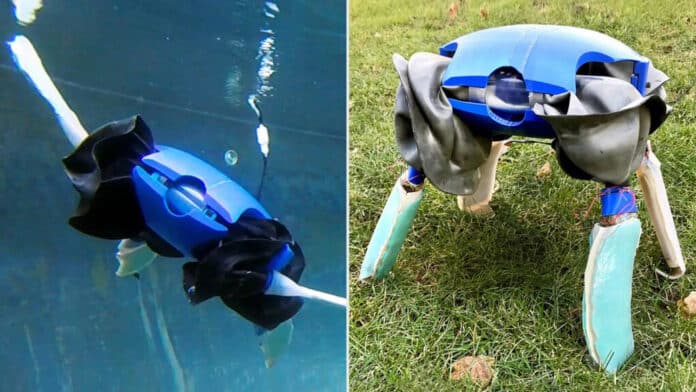The current proliferation of mobile robots spans ecological monitoring, warehouse management, and extreme environment exploration to an individual consumer’s home. This expanding frontier of applications requires robots to transit multiple environments, a substantial challenge that traditional robot design strategies have not effectively addressed.
The researchers at Yale University have created a robot that can move on both water and land. The robot, ART (Amphibious Robotic Turtle), is capable of morphing its legs into flippers when it reaches the water – through a process researchers dubbed “adaptive morphogenesis.”
The robot takes inspiration from water and land turtles, a group whose fossil record spans over 110 million years. “Terrestrial and aquatic turtles share similar bodies, with four limbs and a shell, but have distinctive limb shapes and gaits adapted for their specific environment,” said Rebecca Kramer-Bottiglio, principal investigator of the study. “Sea turtles have elongated flippers for swimming, whereas land turtles and tortoises have rounded legs for load bearing while walking.”
It features morphing limbs that can adapt their shape, stillness, and behavior to the environment. The morphing limbs use variable stiffness materials and artificial muscles to transform their shape when transitioning from one environment to another.
In its legged state, the tortoise-inspired amphibious robot can traverse land with a variety of four-legged terrestrial gaits. Upon reaching the water, the robot can morph its legs into flippers, enabling it to swim with lift- and drag-based aquatic gaits.
The ART robot differs from other amphibious robots by leveraging shape adaptation to use the same parts for propulsion in both water and land environments. Other approaches add multiple propulsive mechanisms to the same robot, using a different one in each environment, which can lead to energy inefficiencies.
“Our results show that adaptive morphogenesis can enhance the efficiency of robots that locomote through multiple environments,” said Rebecca Kramer-Bottiglio.
The researchers envision numerous potential applications for their Amphibious Robotic Turtle, including the monitoring of ecosystems along shorelines, diver support, and ocean farming. The robot will also help researchers to study the physics of locomotion in the complex surf zone – where waves, currents, and turbidity make it particularly tricky for robotic devices to navigate – and other environmental transition zones.
Journal reference:
- Robert Baines, Sree Kalyan Patiballa, Joran Booth, Luis Ramirez, Thomas Sipple, Andonny Garcia, Frank Fish and Rebecca Kramer-Bottiglio. Multi-environment robotic transitions through adaptive morphogenesis. Nature volume 610, pages283–289 (2022). DOI: 10.1038/s41586-022-05188-w
